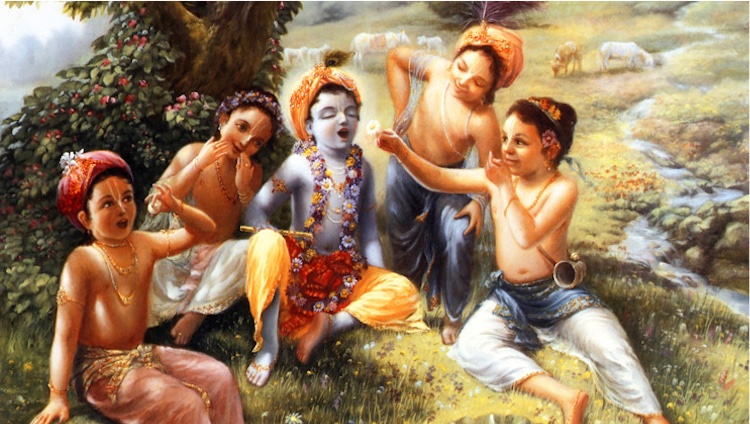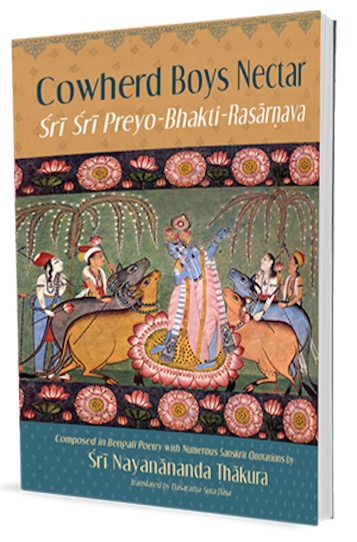Book Review: Cowherd Boys Nectar
By Swami B. A. Ashram | Jan 12, 2019

(Cowherd Boys Nectar: Sri Sri Preyo-Bhakti-Rasarnava by Sri Nayanananda Thakura (translation, introductory essays, and appendixes by Dasaratha-Suta Dasa. Bookwrights Press, 233 pages)
At the beginning of the chapter of Srimad-Bhagavatam relating Krsna’s pastime with his friends and the demon Aghasura, Sukadeva Goswami describes the cowherd boys’ typical daily behavior when they took the calves out to the pastures and forests. Essentially, they horsed around, much as any preadolescent country boys might. They might steal each other’s lunch bags and play keep-away with them. They’d play games. Sometimes they would play in the waterfalls. Or imitate the animals they’d see in the forests. They might play on their flutes and bugles, or shout ill names down wells, pretend to get mad when the insults came back as echoes, shout new ones, and on and on. Sometimes, playing like monkeys, they’d climb in the trees. Sharing these pranks with King Pariksit and the sages in attendance, Sukadeva voiced his astonishment: Krsna is the Complete Absolute Truth, the fountainhead of all existence! What kind of good fortune could explain these boys hanging out with him as a buddy?
ittham satam brahma-sukhanubhutya dasyam gatanam para-daivatena
mayasritanam nara-darakena sakam vijahruh krta-punya-punjah
“In this way, all the cowherd boys used to play with Krsna, who is the source of the Brahman effulgence for jnanis desiring to merge into that effulgence, who is the Supreme Personality of Godhead for devotees who have accepted eternal servitorship, and who for ordinary persons is but another ordinary child. The cowherd boys, having accumulated the results of pious activities for many lives, were able to associate in this way with the Supreme Personality of Godhead. How can one explain their great fortune?” (SB 10.12.11)
My beloved spiritual master, A. C. Bhaktivedanta Swami Prabhupada, recalled such pastimes with deep affection on a number of occasions. Satsvarupa das Goswami’s Srila Prabhupada Lilamrta recounts his doing so in a casual, intimate meeting with two or three disciples. The Goswami writes, “Prabhupada’s eyes flashed, and he rubbed his hands together, smiling. “I simply want to go to Krsnaloka, so I can have some of Krsna’s laddu and kacauris. I do not have any great diversion from this. I simply want to go there so that I can enjoy eating laddus and kacauris with Krsna and the cowherd boys.”Srutakirti das recalls another intimate moment as he massaged Srila Prabhupada in his room in Atlanta in March 1975. He said that as Srila Prabhupada was being massaged, he gazed at a picture of Krsna and Balarama with their friends in the forest, as if he had entered the pastime himself. Srutakirti tells us,
So as I was massaging, Prabhupada all of a sudden said, “I like the cowherd boys very much. . . . Every day Krsna and Balaramawould go into the forest in Vrndavana. Before they would go, Their mothers would make lunches, prepare tiffins for Them.” I’m just shaking my head. Prabhupada is speaking very softly. Prabhupada is just there, right there inside that scene, and he is speaking about it. When Prabhupada talked, he would just bring you, he would transport you right there. So he said, “Krsna’s mother Yasoda, she would make very nice tiffin and in it there would be puri, halava,nkacauri, laddu. And the other cowherd boys, their mothers were not so opulent, so their tiffins would have chapati,rice, subji, like that.”
And then he said, “Then they would go and they would play all day, and they didn’t have the cows. They are just little boys so they would have the calves. The calves were with them. Then finally they would stop for lunch. Sometimes one of the cowherd boys would steal Krsna’s lunch and begin throwing it around; they would play keep-away with Krsna.” I’m just massaging the whole time. He said, “Finally the cowherd boys would throw their lunch to Krsna, and they would sit down with His lunch and they would eat puri, halava, kacauri, and laddu. And Krsna would sit with them and He would eat the rice, chapati, and subji.” He was smiling so brightly. And then he stopped, and I’m still massaging. Then he said, “I just want to go back to the spiritual world and eat kacauri and laddu with Krsna.”
Many of Srila Prabhupada’s disciples could sense his affinity for cowherd pastimes. And his enthusiasm was infectious; many disciples have found, as their spiritual lives mature, that they also find Krsna’s dealings with his cowherd friends irresistible.
Dasaratha-Suta Dasa’s translation of Sri Nayanananda Thakura’s Sri Sri Preyo-Bhakti-Rasarnava has, as many of us are well aware, been out of print for twenty years or more. Health problems have kept him from reviving his Nectar Books publications. Because Preyo-Bhakti-Rasarnava is the most popular of his titles, eager devotees have been, however reluctantly, reduced to photocopying and scanning old copies (and copies of copies) for sharing. We know readers and author alike find this a less-than-desirable situation, and devotees have been asking Dasaratha-Suta for years when the book would be available again.
That time is now. At last this classic text has been re-released by Bookwrights Press as Cowherd Boys Nectar. Newly edited and designed, with many old cowherd-boy paintings to illustrate it, this volume will no doubt find itself a welcome addition to many discriminating readers’ libraries.
Sri Nayanananda Thakura lived in West Bengal in the 17thcentury. He was initiated in the disciplic lineage from Sundaranananda Thakura, an intimate associate of Lord Nityananda’s identified with Sudama Sakha. Sudama is one of Krsna and Balarama’s chief cowherd friends, the leader of the group known as priya sakhas. These boys are the same age as Krsna, and their friendship is not mixed with any of the other moods through which the residents of Vrindavan serve the Lord. Sri Sri Preyo-Bhakti-Rasarnava (The Nectar Ocean of Fraternal Devotion) naturally highlights the mood of Krsna’s priya sakha sand will prove particularly useful to those sadhakas (practitioners) who aspire to follow that mood. All the same, it has much to recommend it to all devotees of Krsna.
Those who read Cowherd Boys Nectar will find in it nourishment, opening of the heart, and delight, often all at once. Dasaratha-Suta’s introductory essays help the reader understand the worship of Krsna in transcendental friendship in the context of Gaudiya Vaisnava thought and practice. This includes a history of Sundarananda’s lineage, in which Nayanananda Thakura took initiation and of the sakhya bhava bhakti practiced in Nayanananda’s village of Mangala-dihi.

Nayanananda Thakura opens his book by extolling the supreme virtues of fraternal love for Krsna. This naturally entails brief discussion of the nature and practice of bhaktigenerally, at all levels. Here he draws on essential bhaktitexts such as Srimad-Bhagavatamand Bhaktirasamrta-sindhu. The way the Thakura weaves together instruction, insights and lilafrom these and other sources, including several puranas, Ujjvala Nilamani, Brihad Bhagavatamrtam, and Govinda Lilamrtam, in his first few chapters creates a sort of crash course, or refresher course, in sambandha jnana, a conceptual orientation toward Bhagavan Krsna, that nourishes the sadhakas’ faith in bhakti, in a way that strengthens and deepens their practice, especially for those in pursuit of sakhya rati.
Sri Nayanananda then gives a couple of chapters introducing the reader to Sudama Sakha, his 64 principle friends, to their world and their relationships with Krsna and Balarama. This section helps all practitioners better appreciate the deep, sweet nature of Krsna bhakti, with a richness that is likely calculated to break open their hearts, so some of that sense of devotion may seep in and infect them with divine emotion. These chapters will help neophyte practitioners better appreciate the lives and divine service of Sudama and other Vraja gopas. They simultaneously benefit more advanced practitioners following Sudama’s love by providing a background for more internal sadhana.
And on this background the author draws an outline of the particular kinds of pastimes Krsna and Balarama enjoy with their cowherd boyfriends, especially with Sudama and his followers. Taking us through the six periods of the day in which Krsna engages with his friends, he treats us to glimpses of Krsna and Balarama’s rising in the morning, the boys assembling at Nanda Maharaja’s home, milking the cows. We also see the games they play during the day, their pastimes in the numerous forests, pastures, and other playgrounds that constitute Vraja dhama. All this naturally will give pleasure to all devotees. Beyond that, it serves as a guide to more advanced followers of Sudama and the priya sakhas in their internal devotional meditation.
Along the way, throughout Cowherd Boys Nectar, readers will find themselves enchanted by the recounting of Sri Krsna’s pastimes with his friends. In these pastimes we discover many wonders, many unanticipated. For example, we find out why cowherd boys throw themselves into the snow. (There’s snow in Vraja? Apparently.) The Thakura’s liberal use of verses, both from sacred texts and of his own composition, as well as a number of songs in Bengali, will further charm his readers. Many of these verses will inevitably find their ways into the treasure houses of devotees’ hearts. I’ll share here one verse that captivated me immediately when I encountered it years ago. This verse, written in a Sanskrit meter called malini, often described as musical, particularly charming, describes the beauty of the brothers Krsna and Balarama.
jaladhara-sasi-varnau gopa-vesau kisorau / sahacara-gana-vrndaih kridamanau vrajesau
nata-vara-jita-vesau nila-pitambaradhyau / jagata-janana-hetu rama-krsnau nato ’smi
The pair with complexions like a raincloud and the moon / The pair dressed as cowherds, the pair of youths
The pair engaged in sporting with the assembly of their friends; / The pair who are Lords of Vraja
The pair whose dress eclipses that of the best of dancers / The pair fond of wearing blue and yellow garments
The pair who are the source of all living entities in the universe / I bow to the pair known as Rama and Krsna.
Dasaratha-Suta enriches his presentation with a collection of appendixes, including a list of the sacred texts Nayanananda cites in Sri Sri Preyo Bhakti Rasarnava, and a list of some 200 of Krsna and Balarama’s cowherd friends, with simple definitions of their names, taken from the Sri Govinda-Vrndavanam section of Brhad-Gautamiya-Tantra. He also includes a brief outline of the activities engaged in during the different periods of the day. And even those who have seen the previous edition will find enchantment in the number of old pictures of cowherd pastimes with which the publishers further enhanced this edition.
Sri Sri Preyo-Bhakti-Rasarnava is, as Dasaratha-Suta writes, an obscure, little-known text. Furthermore, it is not necessarily for everyone. He offers this edition not to satisfy idle curiosity but to provide an opportunity for “quiet study and appreciation.” It gives many serious practitioners aspiring for the practice of raganuga bhaktin insights into the moods and pastimes of confidential sakhya-rati bhajan. And those who may not have such a strong inclination will still find much to nourish their faith and practice, open their hearts to the blessings that will move them to respond to Krsna’s desire, in the words of Srila Krsnadasa Kaviraja, that we all may “dance in ecstasy, realizing the four mellows of devotional service.” And for every sincere reader, this book offers much spiritual pleasure just in the poetic presentation of the Lord’s transcendental beauty and pastimes.
* * *
Cowherd Boys Nectar is available from Bookwrights Press at www.bookwrightspress.com and from Amazon.












